November Monthly Instructional Guide for Students with Complex Access Needs
This month’s focus is on encouraging student communication. The content aligns with Quality Indicator V: Social Communication on the Rubric of Effective Practices for Students with Complex Access Needs and the Administrator Companion Document to the Rubric of Effective Practices for Students with Complex Access Needs. Last month, you concentrated on teaching with rigor, integrating what you learned about your students as you built relationships earlier in the year. This month, we will talk about non-traditional ways students may express themselves and how to build their communication skills. Download or print the November Monthly Instructional Guide Checklist for your reference.
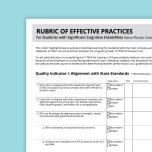
Significant Cognitive Disabilities, Behavior, Instruction, ARD/IEP Supports, Inclusion
Rubric of Effective Practices for Students with Complex Access Needs

Significant Cognitive Disabilities, ARD/IEP Supports, Instruction, Assistive Technology, Behavior, Inclusion
Administrator Companion Document to the Rubric of Effective Practices for Students with Complex Access Needs
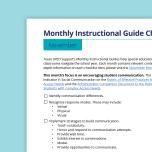
Significant Cognitive Disabilities
November Monthly Instructional Guide Checklist
Identify Communication Differences
Students with complex access needs may not be able to communicate and participate in conversations and classroom activities in traditional ways. It may be difficult for them to “show what they know.” While most students can articulate or provide written responses to communicate, students with complex access needs may need a communication partner to identify and inform others of a change in affect, different vocalizations, or small bodily movements as attempts at communication. Still others may need assistive technology with augmentative and alternative communication (AAC) to express themselves. Identifying the communication differences of your students helps you plan appropriate activities with their particular response modes integrated to allow for participation.
Recognize Response Modes
Recognize student response modes, understanding that they may be non-traditional.
- Verbal
- Physical
- Visual
If you have students who do not yet have an authentic response mode, the free online Building an Authentic Academic Response course can help you with planning their instruction and supports.
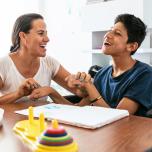
Significant Cognitive Disabilities, Instruction
Building an Authentic Academic Response for Students with Complex Access Needs
Verbal
Some examples of verbal responses are:
- verbal statement, including word approximations;
- communicating “yes” or “no” when presented with answer choices one at a time and asked, “Is this the …?”;
- forming responses with the assistance of a communication device with preprogrammed answer choices or programmed student vocabulary;
- using an output device to indicate the answer when each answer choice is presented individually;
- vocalizing positively or negatively to indicate the answer when each answer choice is presented individually;
- making a negative vocalization to indicate an unmatched object;
- describing the location of the answer; or
- responding with a letter, number, or color name if the answer choices are so labeled.

The student uses a communication device to answer multiple choice questions. Shannon Beyer-Kaminski, 2022; The student uses a communication device to answer questions about Texas state symbols. Shannon Beyer-Kaminski, 2022
Physical
Some examples of physical responses are:
- pointing to, reaching for, or touching an answer;
- highlighting, coloring, circling, or otherwise marking a response;
- nodding, smiling, or gesturing to indicate “yes” or “no” when presented answer choices one at a time and asked, “Is this the…?”;
- manipulating words, sentences, or sections of a recreated answer choice;
- using calculators, manipulatives, or math tools (fraction pieces, geometric shapes, number lines, counting charts, money, base-ten blocks, counters) to arrive at and display an answer;
- writing or typing responses with or without the use of adaptive writing equipment;
- signing a response;
- formulating a response using a choice board;
- isolating answer choices in a section organizer, such as a calendar box or tub;
- nodding or gesturing toward the answer; or
- placing a flag on the answer.

The student manipulates blocks to formulate their answer. Shannon Beyer-Kaminski, 2022; The student places a sticky note over their answer choice. Shannon Beyer-Kaminski, 2023; The student points to her response. Texas SPED Support, 2022
Visual
Some examples of visual responses are:
- gazing,
- blinking,
- winking, or
- fixating on an answer choice.

The student gazes in the direction of her choice. Texas SPED Support, 2022
Implement Strategies to Build Communication
Communication skills are woven throughout the TEKS, and we want our students to develop into strong communicators. Build communication skills by implementing purposeful strategies.
- Teach vocabulary.
- Honor and respond to communication attempts.
- Provide wait time.
- Exhibit interest in conversations.
- Model.
- Provide opportunities to communicate.
Teach Vocabulary
Vocabulary instruction is connected to subjects and grade levels. Students need to learn words that allow them to comment, describe, exclaim, question, and engage in conversations. Having the words to communicate enriches students’ participation in all daily activities. Teach your students using both core and fringe words.
Core words are the 80% of words used most often in everyday communication (go, you, the, and, turn, off, etc.) Fringe words are words specific to a certain topic or situation, mostly nouns (cheese, dog, Abraham Lincoln, graph, experiment, etc.)

A simple core word board for a reading activity where the student can direct the person reading aloud. Shannon Beyer-Kaminski, 2019
This is a student’s adapted personal dictionary to go with the novel students are reading in class. Other students are practicing dictionary skills to independently locate the definitions of their vocabulary words. The teacher has reduced the number of words the student is responsible for, and images and definitions are provided to the student to cut/paste into their dictionary under the correct letter. Shannon Beyer-Kaminski, 2022

The Power of Core Vocabulary
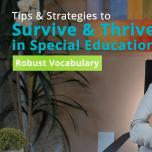
Significant Cognitive Disabilities, Assistive Technology
Robust Vocabulary

Significant Cognitive Disabilities, Instruction
Teaching Literacy to Students with Significant Cognitive Disabilities
Honor and Respond to Communication Attempts
It may take effort for you to discover communicative intent with students who use non-traditional response modes. The student could be trying to communicate through subtle body movements such as blowing bubbles in the sides of their mouth or changing their rate of breathing or vocalizations such as sighing or making squeaking noises.
It can take careful observation for an educator to notice a student’s communication attempt. Often the intended message may not be clear, and that is okay. The educator can still honor the student’s attempt at communication, respond to the student, and extend the conversation by saying things like:
- “I’m not sure what you mean, can you tell me more to help me understand?”
- “Toni, I see you crumpling your mouth. Are you angry?”
- “I just saw you move your hand towards Nicky. Were you trying to get his attention?”
Provide Wait Time
In a conversation, students need time to process what is being said and to formulate a response. For students who use communication systems, the thought processing and motor planning required to formulate an idea and produce the correct action using the system can be time consuming and exhausting.
Giving students wait time before moving on in the communication exchange respectfully gives them the time they need to think about what was said, plan, and execute their response. In the video below, observe how long it takes the child to provide a response.
In the video below, observe how long it takes the child to provide a response.
Exhibit Interest in Conversations
During communication exchanges, and while waiting for a student's response, appear engaged in the conversation. An interested communication partner physically positions themselves facing toward the student, at the student’s level, and leans forward to give nonverbal cues that show they are interested in the conversation. Additionally, it is important to talk directly to the student, clearly engaging with them, rather than deferring questions and conversation to a nearby adult who may be providing support to the student.

The staff are showing their interest in the conversation with their body language. Texas SPED Support, 2022
Model
Modeling is one of the primary strategies for teaching students how to communicate. When working to build a student’s communication skills, modeling can be done by both peers and adults in their conversations and instruction. The model demonstrates using vocabulary in the same response modes and communication systems the student uses. In the video below, watch the educator model how to say the word “go” on the communication device.
Provide Opportunities to Communicate
Students need frequent opportunities to communicate in a variety of environments, for a variety of purposes. While you want your students to be able to communicate for academic purposes so you can record progress, it is imperative that they use communication for social purposes as well. Being able to engage and interact with others is important for safety and a sense of belonging in a community.
Create a language-rich classroom, purposefully plan activities, and stage opportunities throughout the day for your students to practice using their communication skills. Look back at your classroom schedule and identify places where you can encourage students to communicate, both for academic and social purposes. Collaborate with the student’s speech language pathologist to carry over skills being practiced in therapy into the classroom for generalization of skills.

Student communication targets by classroom activity. Shannon Beyer-Kaminski, 2023
Extend Your Learning
Learn more about Quality Indicator V: Social Communication in the free online courses Supporting Communication and Connecting Communication and Instruction.
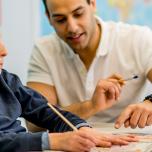
Significant Cognitive Disabilities, Instruction, Assistive Technology
Supporting Communication
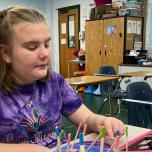
Significant Cognitive Disabilities, Assistive Technology, Instruction
Connecting Communication and Instruction for Students with Complex Access Needs
Final thought: Recognize non-traditional response modes
This month, carefully observe your students for communication attempts. Offer them ways to participate in classroom activities using response modes that align with their skills. Practice modeling and wait time. Design opportunities for functional and spontaneous communication throughout the day and remember to take data to show student growth.
Data Checkpoint
If your campus has a fall break, make sure to take data after the break to monitor for student regression. This is helpful for determining a need for Extended School Year (ESY) services.
Looking ahead
We will encourage you to take some time to evaluate your own professional growth in the December Monthly Instructional Guide.
